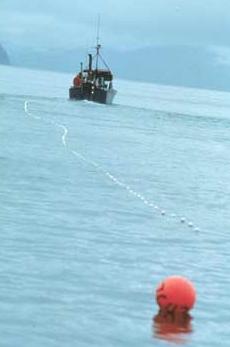|
Gillnets, among the most widespread of fishing gear, are believed to be responsible for much of the world's marine mammal bycatch. Many experts argue that wherever there are gillnets, there is bycatch.
This summer, more than 110,000 Americans supported a petition circulated by Oceana, demanding that NMFS implement a program to count, cap, and control wasted catch, the largest number ever to comment formally on an ocean related issue. The fisheries responsible for such killings use longlines, gillnets and trawl nets - fishing techniques that kill large numbers of non-targeted ocean life.
At the regional meeting of the U.S. Commission on Ocean Policy last month, a coalition of cetacean scientists recommended a number of techniques that could be used to reduce bycatch of marine mammals.
Solutions to the problem of entanglement vary by region and species involved, but can include adding gillnet floats that break away when hit by a whale, acoustic "pingers" that warn marine mammals away from nets and buoy lines that are less likely to snare whales and dolphins.
Setting nets in deeper water, an inexpensive and simple strategy, can also help to reduce bycatch in some cases. Commercial fishers have been crucial in developing these successful gear modifications, the scientists noted.
More information about the lawsuit is available at:
http://www.biologicaldiversity.org or: http://www.oceana.org
|
